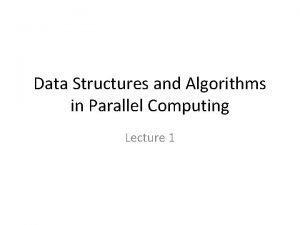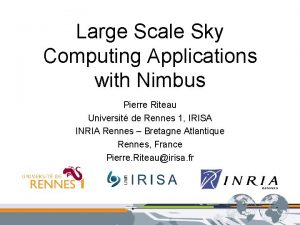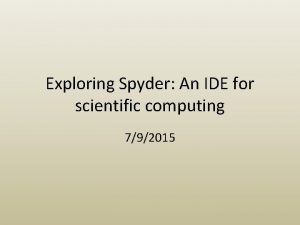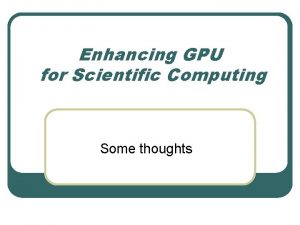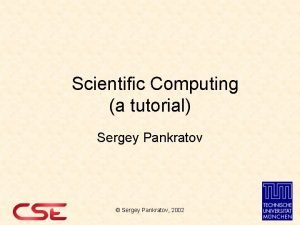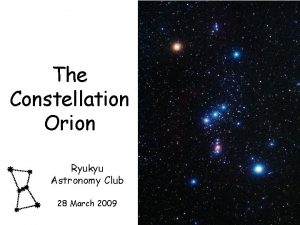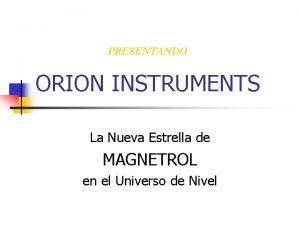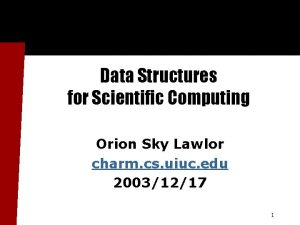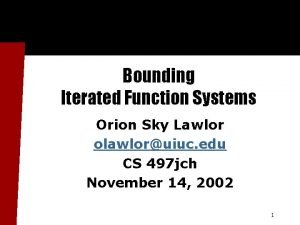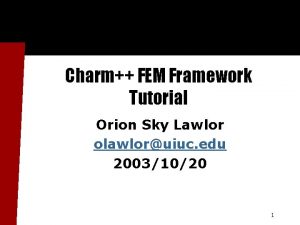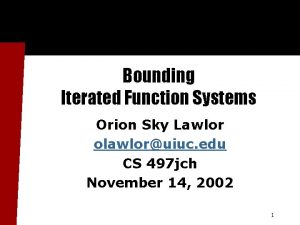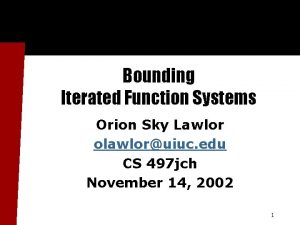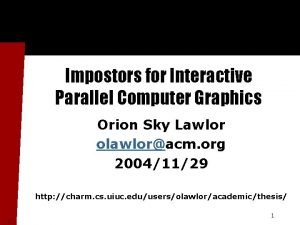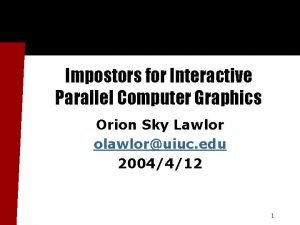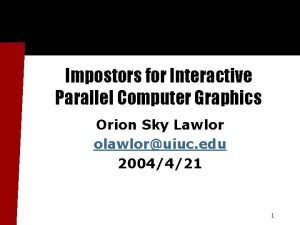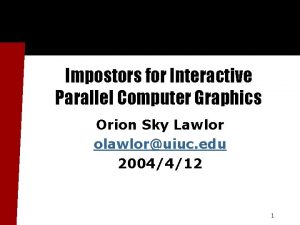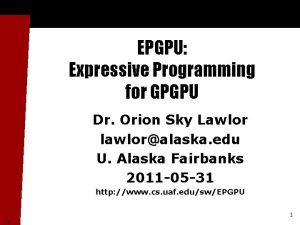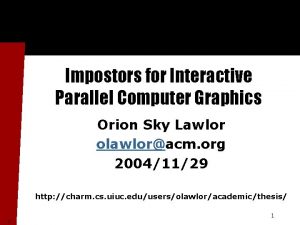Data Structures for Scientific Computing Orion Sky Lawlor






























- Slides: 30

Data Structures for Scientific Computing Orion Sky Lawlor www. cs. uaf. edu 2011/04/14 1

Overview Introduction and Motivation Structured Grids Unstructured Grids Adaptive structured grids Adaptive unstructured grids Particles and Spatial Search Regular grids Trees 2

Introduction / Motivation There are only a few ways to represent the problem domain: Structured Grids Unstructured Grids Particles Knowing the basic terms helps you talk to application folks, and understand their code 3

Grids in General 4

Grids: Introduction So you’re trying to represent some physical situation, like heat flow You decide to divide up space into a bunch of little pieces: Node, or Vertex, or Point Element, or Cell, or Volume 5

Grids: Location of Data Element Centered Data Fluid Dynamics, most PDEs Data values constant (or simple) in a cell Node Centered Data Structural dynamics/FEM Hybrids too, like Arakawa C-grid “Shape function” interpolates between nodes 6

Grids: Motion of Grid and Data Eulerian: non-moving grid E. g. , pressure waves move through the grid in CFD Lagrangian: moving grid E. g. , grid deformation follows the structure deformation in FEM Or hybrid, 7 e. g. “ALE”

Structured Grids 8

Structured Grids: Introduction AKA “Regular Grid”, since grid cells lie in regular rows and columns Cells are stored in a 3 D array Cells can lie along axes (“rectilinear grid”); or curve through space Y X 9

Structured Grids: Terminology “Stencil” of source cells to compute a destination cell Classic GPU algorithm Common in fluid dynamics Also found in PDE solvers x Read-only “Ghost” or “Dummy” cells around boundary 10

Structured Grids: Applications Fluid Dynamics Jacobi and other PDE solvers “Finite Difference” formulation Level set methods Classical fluid dynamics grid E. g. , fluid solidification phase field Image processing Just a 2 D pixel array! 11

Adaptive Structured Grids 12

Adaptive Structured Grids: Intro “Adaptive Mesh Refinement”/AMR Cells are stored in small 3 D arrays, linked together with pointers For regular refinement, use quadtree (2 D) or octree (3 D); can be irregular “block structured AMR” 13 from LLNL SC 98 SAMRAI flier

Adaptive Structured Grids: Terms “Refinement” and “Coarsening” criteria control evolution of mesh Basically simulation error estimates “Hanging Node Constraint” Neighbors must have similar (± 1) refinement level bad! 14

Adaptive Structured Grids: Apps Adaptive physics solvers LLNL SAMRAI C++ Framework NASA GSFC PARAMESH AMRITA (James Quirk) INRIA GPU Gems 3: 5 15

Unstructured Grids 16

Unstructured Grids: Introduction AKA “Mesh” Cells are stored in 1 D array Vertices (“nodes”) of each cell (“element”) are listed explicitly Mesh consists of triangles and/or quadrilaterals (2 D); tetrahedra, cubes/hexahedra, prisms, pyramids (3 D) 17

Unstructured Grids: Terms “Ghost regions”, like structured grids “Shared nodes” along partition boundaries: Run computation on separate pieces Add up node forces along boundaries 18

Unstructured Grids: Terms “Conformality” Nodes never land in middle of element Enforced during mesh generation/modification bad! 19

Unstructured Grids: Applications Structural Mechanics Fluid Dynamics This is the classic finite element mesh In strange domains, where structured grids are tough to automatically generate Can be extended to Adaptive Meshes! 20

Adaptive Unstructured Grids 21

Adaptive Unstructured Grids: Intro AKA “Mesh Refinement”, shades into from-scratch “Mesh Generation” Cells still stored in 1 D arrays, but the cells can now change Must respect conformality Must ensure element “quality” Must work in parallel 22

Adaptive Meshes: Terminology “Delaunay” mesh and “flip” “Edge bisection”: cut edge in middle 23

Adaptive Meshes: Applications Almost every unstructured mesh program wants to be adaptive. Charm++ Triangle Mesh Refinement (Wilmarth) Charm++ PMAF 3 D (Wilmarth) Charm++ Tet Data Transfer Library (Lawlor) 24

Particle Methods and Spatial Search 25

Particles and Spatial Search To work on a particle, you need nearby particles E. g. , all particles within cutoff r • Used for molecular dynamics (NAMD) or, all k nearest particles • Used by Smoothed Particle Hydrodynamics (SPH) methods Search for neighboring particles is spatial, so need a “spatial search structure” Can use: structured grid, adaptive 26 search tree, unstructured grid, . . .

. . . using Structured Grids E. g. , NAMD molecular dynamics Particles are Atoms Search structure is based on “Patches” of space in regular, rectilinear grid atoms over here. . . never talk to atoms over here E. g. , Charm++ Collision Library Search structure is based on 27 regular rectilinear voxel grid

. . . using Search Trees E. g. , Cosmology simulations Particles are stars, galaxies Search structure is a spatial octree SPH: “Smoothed particle hydrodynamics” Barnes-Hut gravity “Tree walk” 28

Conclusions 29

Conclusions There are only a few ways to represent the problem domain: Structured Grids Unstructured Grids Particles There a lot of specialized terms, but very few concepts 30
 Gerry lawlor
Gerry lawlor Dr colleen lawlor
Dr colleen lawlor Dr frances lawlor
Dr frances lawlor Data structures for parallel computing
Data structures for parallel computing Blue sky computing
Blue sky computing Sky computing
Sky computing Homologous
Homologous Virtualization ppt
Virtualization ppt Conventional computing and intelligent computing
Conventional computing and intelligent computing 792015
792015 Best gpu for scientific computing
Best gpu for scientific computing Scientific computing tutorial
Scientific computing tutorial Information gathered during an experiment
Information gathered during an experiment How is a scientific law different from a scientific theory?
How is a scientific law different from a scientific theory? Greek god orion
Greek god orion Orion unillanos
Orion unillanos Orion constellation mythologie
Orion constellation mythologie Orion alpha a28f
Orion alpha a28f Méthode orion exemple
Méthode orion exemple Orion context broker
Orion context broker Rion pharma
Rion pharma Methode orion
Methode orion Orion philosophy
Orion philosophy Zojm wrocław
Zojm wrocław Orion context broker
Orion context broker Orion
Orion Bold orion
Bold orion Orion magnetrol
Orion magnetrol Orion
Orion David kallend
David kallend Gpon light orion
Gpon light orion



